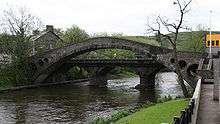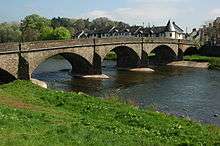William Edwards (architect)
William Edwards (February 1719 – 7 August 1789) was a Welsh Methodist minister who also practised as a stonemason, architect and bridge engineer.
Edwards was born the son of Edward David in Eglwysilan, Caerphilly County Borough, and began preaching in his early twenties. In 1745 he became joint pastor of a newly established Independent chapel at Groeswen, remaining in the post until his death.[1]
He taught himself the rudiments of masonry and at the age of 27 was commissioned to build a bridge over the Taff for £500 and to maintain it for 7 years. After several attempts he succeeded and went on to build further bridges across South Wales.
On his death he was buried in St Ilan's church in Eglwysilan, where his tomb is a grade II* listed structure.[2]
Three of his sons (Thomas, David and Edward) also became bridge builders, two of whom built Newport bridge in 1801. A fourth son (William) was killed in action at Gibraltar.[3]
Famous bridges

Edwards' most famous creation was the Old Bridge at Pontypridd, built between 1746 and 1756. The contract included a "guarantee" clause, and Edwards actually constructed four successive bridges at the same site, with only the last surviving the torrential waters of the River Taff. The first bridge had three arches which were swept away by flood water after two and a half years. The second, a bold single arch design, was also swept away before completion. The third attempt failed due to the weight of the haunches causing the centre to fail.
At 140 ft, the fourth and final version was the largest single-span bridge in the world when it was completed, exceeding the previous largest, the Rialto Bridge in Venice, by some 42 feet. Edwards' master-stroke was to lighten the weight of the haunches by leaving "holes" in the structure. The resulting construction still stands today, although another bridge next to it carries modern traffic and Edwards bridge is only now used by pedestrians. The bridge opened in 1755 and celebrated its 250th anniversary in 2005.
Edwards also went on to build or design bridges in Aberafan, Betws, Cilycwm, Glasbury, Pontardawe and Usk, and was also responsible for the layout of Morriston, the planned industrial village near Swansea developed by the Swansea Valley industrialist Sir John Morris.[1]
Works by Edwards (and sons)
- Source [4]
- c. 1740 Forge at Cardiff
- 1746–1756 Old Bridge, Pontypridd. 1 arch, 140 ft span.
- 1746–1752 Usk Bridge, Usk. 5 arches. Widened 1856.
- ? Beaufort Bridge. 3 arches. Demolished 1868.
- ? Pontardawe Bridge. 1 arch, 80 ft span.
- ? Betws Bridge. 1 arch, 45 ft span.
- 1760s Workshops at Morriston
- c. 1768 Aberafan Bridge, 1 arch, 70 ft span. Demolished 1842.
- c. 1768 Morriston new town.
- 1773 Dolauhirion Bridge. 1 arch, 84 ft span. Built by son Thomas Edwards.
- 1777 Glasbury Bridge. 7 arches. Built by son Thomas Edwards. Destroyed by flood, 1895.
- 1778 Wychtree Bridge. 1 arch, 95 ft span. Demolished 1959.
- 1782 Chapel of Libanus, Morriston (part-time)
- 1787 Cenarth Bridge, Carmarthenshire. Built by son David.
 Old bridge in Pontypridd
Old bridge in Pontypridd Usk bridge
Usk bridge.jpg) Old bridge at Pontardawe
Old bridge at Pontardawe Dolauhirion bridge, Cilycwm
Dolauhirion bridge, Cilycwm Cenarth bridge
Cenarth bridge
Literature
- Colvin H. A. (1995) Biographical Dictionary of British Architects 1600–1840, Yale University Press, 3rd edition London, 336-337. Provides listing of his work with references to further articles about Edwards.
See also
References
- 1 2 The Welsh Academy Encyclopaedia of Wales. John Davies, Nigel Jenkins, Menna Baines and Peredur Lynch (2008) pg106 ISBN 978-0-7083-1953-6
- ↑ "Tomb of William Edwards in the churchyard of St Ilan, Eglwysilan, Aber Valley". British Listed Buildings. Retrieved 14 January 2014.
- ↑ "EDWARDS , WILLIAM". Welsh Bibliography Online. Retrieved 20 December 2013.
- ↑ Skempton, A.W. (2002). A Biographical Dictionary of Civil Engineers in Great Britain and Ireland.